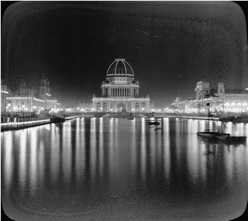Perception is Reality! Just the Facts!

The Grand Basin
Summertime and vacations are traditionally a great time to read a good book. With time on our hands, a book is a great escape. I read a book recently which I think many of you may be familiar with or have read already: The Devil in the White City, Murder, Magic and Madness at the Fair that changed America by Erik Larson. Don’t worry, this is not a book review, I will leave that up to you. The story and the way Larson was able to weave two distinctly disparate stories was in itself entertaining, but what fascinated me most was the story of the architects.
In 1893, Chicago was “a greedy, hog-slaughtering backwater.” Whereas New York had developed into a city of refinement and East coast “elites,” Chicago was still considered an undeveloped backwater filled with the country bumpkins and immigrant workers.
That the city won the bid for the 1893 World’s Fair was a triumph, but the real triumph as it turns out was the work of the architects and designers of the World’s Fair itself. Built in just 26 months, that fact alone would not seem so daunting if it weren’t for the sheer size and scope of the fair. Built along the banks of the Lake Michigan on an insect infested swamp, now known as Jackson Park, the fair became known as the “White City” due in part to a mixture of plaster, cement, and jute fiber called “staff.” The material was painted white, giving the buildings their gleam. “It was designed to follow Beaux Arts principles of design, namely French neoclassical architecture based on symmetry, balance, and splendor. The exposition covered more than 600 acres, featuring nearly 200 new (but purposely temporary) buildings, canals, lagoons, and people and cultures from 46 countries. More than 27 million people attended the exposition during its six-month run.”
Daniel Hudson Burnham (of Burnham & Root) was chosen to lead the construction of the fair and was given the rare opportunity to select architects from Chicago and around the country to participate in its design. He brought together many of the great architects of his time along with sculptor Augustus St. Gaudens and artist Francis Millet. He overcame tremendous physical, psychological and financial obstacles to complete the construction on time. History has shown the fair to have been a great success and a true testament to the sheer will and determination of one man, who was able to secure the civic pride that, ran so deep in Chicago and the rest of the country at the threshold of the 20th century.
Below are some interesting facts from the fair. Enjoy!
- The 1893 World’s Columbian Exposition commemorated the 400th anniversary of Columbus’s discovery of America and was known as the “White City.”
- The Exposition lasted 6-months and drew over 27 million visitors, more than 40% of the United States’ population at the time.
- During its best day, it drew over 700,000 visitors.
- A new snack was introduced to visitors called “Cracker Jacks.”
- A new breakfast food was introduced called Shredded Wheat.
- Movies were introduced to mass audiences in a 1,500 seat theater in the “Streets of Cairo” exhibit.
- A single exhibit hall had enough interior volume to have housed the U.S. Capitol, the Great Pyramid, Winchester Cathedral, Madison Square Garden, and St. Paul’s Cathedral, all at the same time!
- The machine known as the “monstrosity” (the Ferris Wheel) became the fair’s emblem, a machine so huge and terrifying that it instantly eclipsed the tower of Alexandre Eiffel that had so wounded America’s pride.
- Never before had so many of history’s brightest lights been at one event, including Buffalo Bill, Theodore Dreiser, Susan B. Anthony, Jane Addams, Clarence Darrow, George Westinghouse, Thomas Edison, Henry Adams, Archduke Francis Ferdinand, Nikola Tesla, Ignace Paderewski, Philip Armour, and Marshall Field.
- Richard Harding Davis, the noted journalist and fiction writer, called the exposition “the greatest event in the history of the country since the Civil War.”
- Fire during construction killed 15 people.
- An assassin transformed the closing ceremony from what was to have been the century’s greatest celebration into a vast funeral.
- The country’s most infamous serial killer, H.H. Holmes, born in New Hampshire, used the exposition as a backdrop to kill an estimated 100 victims and was later arrested in Boston and eventually hanged for his crimes in Philadelphia in 1896.
- Designers of the World’s Fair were: Daniel Hudson Burnham, John Wellborn Root, George Post, M.B. Pickett, Henry Van Brunt, Francis Millet, Maitland Armstrong, Col. Edmund Rice, Augustus St. Gaudens, Henry Sargent Codman, George W. Maynard, Charles McKim, Ernest Graham, Dion Geraldine, Louis Sullivan, and Frederick Law Olmstead.
- New York Editor Charles Anderson Dana nicknamed Chicago “the Windy City” after the boastful leading men of the city, not the persistent southwesterly breeze.
- Designers of the first building in the country ever to be called a skyscraper: Chicago architectural firm Burnham & Root.
- $1,000 ($30,000 in today’s dollars): The consulting fee offered to Olmstead to participate in the design of the fair, which he turned down initially. He later accepted $26,000 fee for design ($670,000 in today’s dollars).
- Gas jets were still the primary source of illumination in the country.
- “Make no little plans; they have no magic to stir men’s blood,” noted Daniel Burnham.
- During the planning and building of the Exposition, Frederick Law Olmstead was in the middle of installing the landscape around the Vanderbilt Mansion in Asheville, North Carolina.
- The Eiffel Tower and the Paris World Fair of 1893 was the impetus for the grandeur and opulence of the White City.
- The fair was built in less than 26 months.
